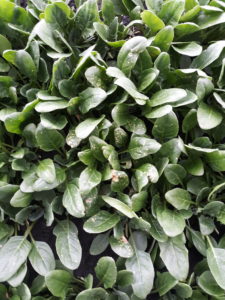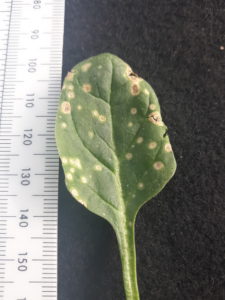While many growers use high tunnels to extend the growing period for warm-season crops such as tomatoes or cucumbers, it is also possible to grow cool-season crops such as spinach well into winter. The winter over much of Indiana has been rather mild; spinach and other cool-season crops should be doing well. However, disease and insect pests may be a problem.
In the first week of March, I observed leaf spot on spinach growing in a high tunnel (Figure 1). Note that the lesions occur on a cluster of plants indicating possible spread of a fungus. A closer look shows that the center of the lesion may be dark with fungal sporulation (Figure 2). I was able to confirm the disease as Cladopsorium leaf spot of spinach.
Little is known about the biology of the fungal pathogen. However, the disease is favored by rainy or at least moist weather. The pathogen may be seedborne. I have found no information about the temperature at which the disease is favored; I was surprised by the presence of the disease when it was snowing outside the high tunnel. However, it is possible that the lesions caused by the disease were present on the leaves and yet the pathogen may not have been active. Cladosporium probably survives for a period in crop residue; therefore, crop rotation should help to reduce disease severity.
There is also not much information about possible control measures. Use seed that has been tested for Cladosporium and other pathogens and/or treat seed in hot water or bleach. Overhead irrigation may increase the severity of the disease. The Northeast Vegetable Guide lists Lifegard® at first true leaf stage or after thinning. Many copper products are labeled for spinach however, I can find no copper products that list Cladosporium leaf spot. Plus, many copper products warn that leaves may be spotted by copper. Lifegard® is listed by the Organic Materials Review Institute (OMRI) and therefore may be certified in most organic schemes. Some copper products may be OK to use organically.
It is not clear how important Cladosporium leaf spot will be in spinach production in Indiana.

